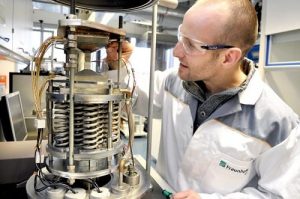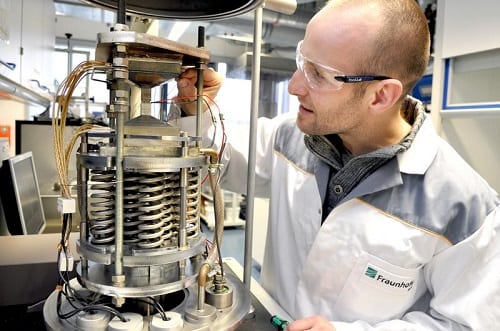Currently, less than half of the energy used in industrial processes, transport or households is actually utilized. The majority of primary energy still escapes despite numerous energy-saving measures as waste heat into the environment.
Thermoelectric generators (TEG) can help to transform this wasted heat energy into electricity. However, there are still obstacles in terms of cost efficiency, availability of raw materials, processing and environmental sustainability of the applied thermoelectric materials.
Ceramic materials provide a solution with an exceptionally flexible property range. They can be produced environmentally friendly from readily available raw materials. Up to now, ceramic TEGs for only limited tasks and low energy conversion efficiency were realized.

Test stand for efficient and autonomous power generation of waste heat. Source: IKTS
Fraunhofer IKTS has extensive know-how regarding the production of ceramic thermoelectric materials. As the first German research institute, IKTS managed the cost-effective production of fully functional ceramic TEGs that have a long lifetime and can be used at high temperatures, which makes them energetically interesting.
“We offer our customers economically attractive ceramic TEG modules, with which valuable waste heat can be converted into electricity independently and reliably – and at temperatures of up to 1000°C. Such robust, maintenance-free and particularly durable TEGs are attractive for a variety of applications, e.g. in metallurgical processes, or in the hot zones of internal combustion engines.” says Hans-Peter Martin, head of the group Nitride Ceramics and Structural Ceramics with Electrical Function at Fraunhofer IKTS.
Scientists at the Fraunhofer IKTS offer a customized development of ceramic TEG modules – adapted for the conditions of the host process. Therefore, the ceramic components are optimized in terms of electrical parameters, chemical interactions and geometrical requirements, and when requested, integrated into the individual thermal system.

















